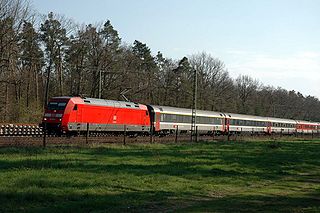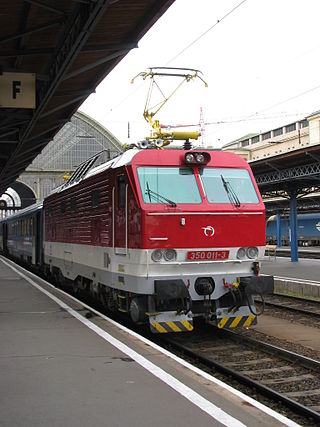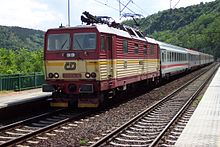
The Austrian Federal Railways, now commonly known as ÖBB, is the national railway company of Austria, and the administrator of Liechtenstein's railways. The ÖBB group is owned entirely by the Republic of Austria, and is divided into several separate businesses that manage the infrastructure and operate passenger and freight services.

InterCity is the classification applied to certain long-distance passenger train services in Europe. Such trains generally call at major stations only.
České dráhy, often shortened to ČD, is the major railway operator in the Czech Republic providing regional and long-distance services.

The Emperor Franz Joseph Railway was an Austrian private railway company, named after Emperor Franz Joseph I. It operated railway lines from the Austrian capital Vienna to Prague and Eger (Cheb) in Bohemia.

Wien Franz-Josefs-Bahnhof is a train station in the Alsergrund district of Vienna, Austria. It serves as the southern terminus of the Franz-Josefs-Bahn.

Railjet is a high-speed rail service in Europe operated by Austrian Federal Railways (ÖBB) and Czech Railways (ČD). Branded as Railjet Express (RJX) for the fastest services and as Railjet (RJ) for services with additional stops, it was introduced in 2008 and operates at speeds of up to 230 km/h (143 mph). Railjet is ÖBB's premier service and operates both domestically within Austria and on international services to adjacent major cities in the Czech Republic, Germany, Switzerland, Italy, Hungary and Slovakia.

Innsbruck Hauptbahnhof is the main railway station in Innsbruck, the capital city of the Austrian federal state of Tyrol. Opened in 1853, the station is a major hub for western and central Austria. In 2019, it was the 8th-busiest station in the country, and the 2nd-busiest outside of Vienna after only Linz Hauptbahnhof, with 315 train movements and 38,500 passengers daily.

A Schnellzug is an express train in German-speaking countries, where it refers to trains that do not stop at all stations along a line. The term is used both generically and also as a specific train type. In Germany and Austria it is also referred to colloquially as a D-Zug, a short form of Durchgangszug, and express train services were often given numbers preceded by the letter D. The similar term, snälltåg, was used in Sweden until January 1980.

The Děčín–Dresden railway, also called the Elbe Valley Railway is an electrified main line in Saxony and the Czech Republic. Formerly called the Saxon-Bohemian State Railway, the line is part of the Dresden to Prague route and is one of Europe's most important trunk routes (Magistralen). It runs along the Elbe Valley from Děčín via Bad Schandau and Pirna to Dresden. The first section of the line was opened in 1848 and is one of the oldest lines in Germany.

Brno main railway station is the principal railway station in Brno, the largest city in Moravia and the second largest in the Czech Republic. The railway station is situated in the city centre on the site of the former city walls. It is one of the oldest railway stations in the Czech Republic, having been in operation since 1839.

Klagenfurt Hauptbahnhof is the main railway station in Klagenfurt, capital of the Austrian state of Carinthia. It is an important railway junction in southern Austria.

RegioJet a.s. is a private Czech provider of passenger rail and bus transport. The company Student Agency, owned by Czech businessman Radim Jančura, is the sole owner. A sister company of the same name, with its registered office in Bratislava, is an operator of passenger rail and bus transport in Slovakia.

The German rail network provides connections to each of its neighbouring countries, many of which are under the EuroCity classification. EuroCity services are part of the Intercity network - many EC services represented a couple of train pairs on an IC route extended across the border, while other routes are served primarily by EuroCity services. EuroCity services are generally locomotive-hauled, using Intercity rolling stock, either from Deutsche Bahn or one of the other countries along the route.

Lindau-Insel station is the largest station in the city of Lindau (Bodensee) and was its most important station until passenger service resumed at Lindau-Reutin station on December 13, 2020. In the urban area there is also Lindau-Aeschach station and Lindau-Reutin freight yard. Formerly there were also Lindau-Siebertsdorf, Lindau Langenweg, Lindau Strandbad, Schoenau, Oberreitnau and Rehlings.

Břeclav railway station is an important international railway junction in the Czech Republic, located in the town of Břeclav in South Moravia, close to the borders with Austria and Slovakia.

The Transalpin is a EuroCity express train linking Zürich (Switzerland) with Graz (Austria) via Liechtenstein. Introduced in 2013, it is operated by the Austrian Federal Railways (ÖBB) and the Swiss Federal Railways (SBB-CFF-FFS). From 1958 to 2010 a train of the same name linked Basel or Zürich with Vienna.

Hungaria is a EuroCity train which runs between Budapest Nyugati and Hamburg - Altona, currently running with coaches of MÁV. It is numbered as EC 172-173 and runs daily, mainly with MÁV owned rolling stocks.
The Porta Bohemica is a EuroCity (EC) international express train. Since December 2014 it is operating between Hamburg-Altona and Budapest Keleti.

Siemens Viaggio Comfort is a brand of locomotive-hauled railroad passenger cars built by Siemens Mobility. The car was designed in the early 2000s and was based on the earlier Siemens Viaggio Classic railcars. The railcars were first used in 2008 on Railjet, a high-speed rail service in Europe operated by the Austrian Federal Railways (ÖBB) and Czech Railways (ČD).





















